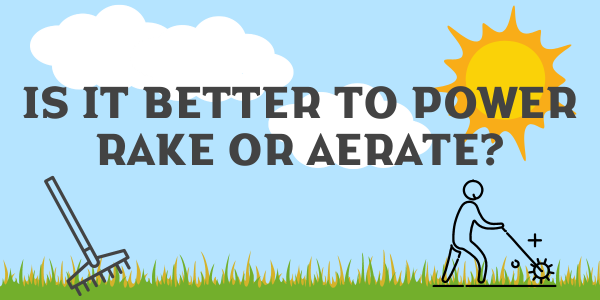Is it Better to Power Rake or Aerate Your Lawn?

Picture this, it’s spring and you’re excited to have a nice green lawn, but you still have stubborn brown and yellow grass that seems to take forever to disappear so you start asking yourself: should I power rake, dethatch or aerate, or do all three???
All good questions to ask when you’re trying to take care of your lawn. Unfortunately, if you turn to the internet, you’ll probably get several different responses so I’m hoping to shed a little light on what we recommend for Southwest Montana.
Let’s address a few things:
- Should you dethatch your lawn?
- Is it better to power rake your lawn?
- Should you aerate your lawn?
We’ll step back and address the grasses that grow in and around Park County and Gallatin Valley, define what dethatching, power raking and aeration are and then answer the questions with our recommendations.
First, what types of grasses grow here? We have cool season grasses, typically a mix of Kentucky Blue Grass and Fescue. Cool season grasses love the temperatures in May and June and Late September and October, but you won’t catch these grasses in the warm climate of the South. Our grass has a very short growing season, usually mid-April to mid-October.
So why is that important? Since we don’t have a very long growing season, our grasses don’t have the chance to build up a thatch layer which brings us to answer the question: is dethatching recommended for my lawn?
Dethatching Recommended?
I’m going to start by saying that each lawn is unique and will need different things based on your mowing practices, soil structure and biology, fertilization practices, etc. so this answer will attempt to address the average lawns that we see.
Dethatching is the practice of removing excess dead grass, debris and whatever else may be between your soil and grass layer (aka thatch), preventing the soil from receiving adequate sun, air and water. This is done via your standard handheld metal rake or something you can tow behind your mower.
At Yard Guard, we find dethatching unnecessary as this practice won’t get rid of all the brown and yellow grass that you’re seeing. Instead, we would prefer that you mow your lawn short in the early spring, think late March/early April, (before it comes out of dormancy) and bagging those clippings. This should give you pretty much the same results in half the time. The other option is to simply do nothing and wait 2-3 weeks until your lawn starts growing evenly.
Is it better to power rake your lawn?
Power Raking is a very aggressive and unnecessary approach. This uses a machine that’s about the same size as a push mower with tines that turn and rip the thatch up from the ground. While this might sound great, our season doesn’t create enough thatch to need this. Also, this approach will not only rip up thatch, but also a large amount of healthy, established roots. While you’ll receive instant gratification by removing some of the brown grass, it actually sets your turf back about a month in terms of its growing season, which is only a couple of months long anyway.
Just like with dethatching, we don’t recommend power raking your lawn. If the brown grass bother you, we recommend one of these two alternatives:
- Do nothing and wait 2-3 weeks for your turf to have even, green growth
- It might seem odd, but get out in late March or early April and mow your lawn on a short setting before it comes out of dormancy and bag the clippings. This will remove the brown grass you see and show more of the new green grass coming through.*
*You can only mow your lawn short while it is still in dormancy. If you are too late and do this once it starts to green up you will stunt its growth.
Should you aerate your lawn?
Compaction is the number one limiting factor in soil. Why? Because compaction restricts air (the main limiting factor in growth), and water (which runs off rather than being absorbed on compact soil), then sunlight (obvious), then nutrients.
With that, let’s talk about aeration. Aeration, whether done mechanically or with a liquid product, is the process of aerifying the soil, allowing more room for oxygen, water, and nutrients to take its place. Compaction is created from the use of the lawn (walking on it, pets, etc), poor soil structure (biology and organic material) and originally from home construction in the first place
If there is one thing we could recommend all of our customers to do every year (outside of being on our Blended Organic Lawn Program) it would be aeration. Whether it be mechanical, liquid or both.
We are now offering a liquid aeration product that we love. It took a while to find one that wasn’t just going to be a temporary solution, aka didn’t use organic material or biology to change the soil structure. So now, our customers are going to receive a better product, not have to mark their sprinkler heads and they don’t have to deal with those plugs everywhere! We’ll be doing this application in the summer so give us a call if you’d like to add it to your lawn care program.
I have always appreciated these questions from customers because they are essentially asking “what is the best thing I can do for my lawn to make it thrive?” I hope that with this blog, it’s more clear about what we recommend for our area. At the end of the day, I don’t want you to waste your time and money on unnecessary services that could have the reverse outcome that you were looking for.
 Billpay
Billpay
